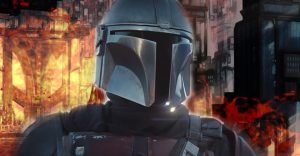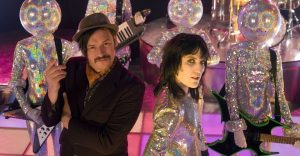Ragnarok Season 2 Ending Explained

Netflix’s Ragnarok is a fantastic modern retelling of the Norse myths – and here’s how season 2 came to an end, setting up an exciting future. In Norse mythology, Ragnarok is not just the famed ‘Twilight of the Gods.’ The Vikings believed history ran in cycles, and Ragnarok marked the end of one cycle and the beginning of the next. However much the world around them changed, the Vikings believed the great themes of history – including the rise and fall of the gods themselves – were cyclical in nature.
Netflix’s Ragnarok TV series explores that idea, imagining a scenario where the cycle is coming to a climax in the modern world. Set in the fictional Norwegian town of Edda, and made by Danish production company SAM Productions, the series taps into the current interest in Norse mythology due to the success of the MCU’s version of Thor. In this story, a number of people discover they are in fact the reincarnations of the gods themselves, and they must fight to protect the world from the Jötnar – the Frost Giants – whose company Jutul Industries is poisoning the world. The star is Magne Seier, a brash teenager who discovers he is the reincarnation of Thor, destined to lead the gods in their ancient, unending war.
Appropriately enough, Ragnarok season 2 is all about the cycle of history, and the relationship most individual characters have with their destiny. This is particularly the case for Magne, who rejects his role and is stripped of his powers – only to be forced into seeking to regain them, by doing exactly what the cycle required of him in the first place. By the end of the season, it’s abundantly clear Ragnarok is imminent, and it remains to be seen whether Magne and his allies can escape their destiny.
How Magne Becomes Thor & Resolves The No-Killing Rule

The Marvel Cinematic Universe may have conditioned viewers to perceive Thor as a superhero, but in reality he’s a warrior. In Ragnarok season 2, Magne realizes that means accepting the need to kill, and this causes him to have a crisis of faith in which he rejects his destiny. The fates strip Magne of his powers, but he soon learns he’s already in too deep, and he needs to regain them in order to save himself and his brother from the vengeance of the Jötnar. It’s telling that Magne can only get his powers back by forging Mjolnir, which is just what he needed to do before attempting to reject his role in the first place. Thus, while the restoration of Magne is portrayed as a moment of triumph, in reality he is submitting to the cycle.
Magne has resolved his personal “No Killing” rule by accepting the gods and Jötnar are above the normal ways of man. Appropriately enough, this is signified by the fact they do not die like ordinary human beings; rather, as Magne learns when he kills the Frost Giant leader Vidar, they crumble to dust. But Magne will no doubt find it difficult to accept any humans who die because they are caught in the crossfire.
Loki’s Serpent Explained (& How It Sets Up Ragnarok’s Ending)

Ragnarok season 2 sees Magne try to reject his destiny – while his half-brother discovers his role in it. Laurits is shaken by the discovery he is actually half-Jötnar, but it doesn’t take long for him to connect himself to Loki, and he eagerly claims that role. He goes so far as to inject himself with Odin’s blood in accordance with the Norse legends in which he became half-Jötnar and half-god. But he doesn’t expect the consequences, when he is diagnosed with a tapeworm; the creature is surgically removed and survives, with Laurits taking it as a pet. He correctly deduces the tapeworm is in fact Jörmungandr, the World Serpent of Ragnarok legend, and uses Jörmungandr to bargain for his life with the Jötnar, promising he has a weapon that can kill Thor.
In Norse mythology, Jörmungandr was one of Loki’s three children. Odin so feared Jörmungandr’s power that he cast the baby serpent into the ocean surrounding Midgard, but in the sea Jörmungandr grew so large he could encircle the entire world. Jörmungandr became Thor’s particular nemesis, with the two fated to battle at Ragnarok; although Thor would defeat Jörmungandr, he would receive a poisoned bite that killed him. Laurits, it seems, is familiar with all this; he takes the role of Odin in casting his World Serpent into the sea, telling his child to grow big and strong so it can kill his half-brother. He understands the cycle of history, and embraces it.
Fjor Has Become Ragnarok’s Main Jötnar Villain

The Frost Giant Fjor is the twisted mirror image of Magne in Ragnarok season 2, in that he too tries to escape his destiny. Frost Giants struggle to control their emotions, and Fjor is overcome by love, rejecting his family and even opposing Jutul Industries for a time. But Vidar’s funeral forces Fjor to accept the duty he owes to his Jötnar clan, and he returns to them to take charge of Jutul Industries. It is immediately clear he is a far more dangerous figure than Vidar, much more spontaneous and aggressive. He needs others to keep him in check, but by the end of season 2 he is no longer going to be willing to listen to his sister Saxa, whose ability to empathize with others would make her a better leader.
Saxa Has Begun To Manipulate Thor

Fjor’s sister Saxa took charge of Jutul Industries for a time, and she would have taken the company in a very different direction – potentially ending the cycle, preventing the company continuing to ravage the planet. But Ragnarok cannot be denied, and when Fjor returns she is displaced. Saxa doesn’t take this well, again trying to exert control over events, and she winds up badly beaten for her apparent treachery. This is how she is found by Magne Seier, and she uses her Jötnar magic to seduce him with a vision of the two making love. Saxa is becoming the traditional “enchantress” figure from Norse legends, the beautiful and seductive woman who delights in manipulating circumstances to her own advantage. The magical powers she possesses appear to outstrip her fellow Jötnar, because none of them have shown the ability to cloud men’s minds as she has. It’s difficult to say what role Saxa will play in Ragnarok season 3; will she continue in her unwitting attempts to break the cycle, or will she be bent to it?
Ragnarok Season 2’s Reincarnated Gods (& Who’s Missing)

Ragnarok season 2 reincarnates a number of the gods, all of whom are destined to play an important role in the Ragnarok cycle. These are:
- Odin the All-Father, all-seeing and all-knowing, even able to hear Magne’s whispered prayers. Like Laurits, he is aware of the cycle, but he appears to be attempting to maintain it.
- Freyja, who possesses the power to manipulate minds – and is willing to use this talent for her own material benefit.
- Tyr the brave, a physical powerhouse with a serious anger management problem, who loses his hand on the mission to forge Mjolnir – in accordance with the Norse legends. He and Freyja fall in love by the end of Ragnarok season 2.
One major god from the legend of Ragnarok has yet to be reincarnated; Heimdallr, destined to raise his horn to signal the onset of Ragnarok, to participate in the final battle, and ultimately to kill Loki. No doubt Ragnarok‘s version will be introduced in season 3, and Laurits will recognize the threat given his understanding of the cycle.
How Ragnarok Season 2 Compares To Norse Mythology

The first season of Ragnarok was heavily criticized by those who are familiar with Norse mythology, because it seemed to draw more inspiration from the MCU than from the legends themselves. The perfect example was Laurits, who was clearly being set up to become Loki – but in the legends Loki is the blood-brother of Odin, not the half-brother of Thor. Season 2 continues to play upon the popularity of the MCU, with Mjolnir sharing the attributes of Marvel’s version – returning to Thor’s hand when he throws it, or being too heavy to be picked up by anyone other than Thor. But this time, the MCU inspiration is blended much more effectively with the Norse mythology. The portrayal of Laurits’ Loki is a particular highlight, with Laurits claiming the role of Odin’s blood-brother in order to enhance his powers, and embracing his destiny with Jörmungandr. Things don’t work out exactly as in the legends – Laurits is the one who releases the World Serpent into the sea, for example – but the broad brush-strokes are the same.
But it’s important to note Ragnarok is more than just a modernized retelling of the legends, in large because the characters are interacting with the cycle, sometimes rejecting it and sometimes attempting to use it in their favor, rather than simply submitting to it. At heart, Ragnarok is a tale of free will versus determinism; can the cycle be broken, or must the world end so the cycle can begin again? At the moment, all the evidence suggests the destinies of gods and Frost Giants are set in stone, with Ragnarok an inevitability. It will be fascinating to see whether Ragnarok pivots away from such a bleak conclusion.
About The Author


















